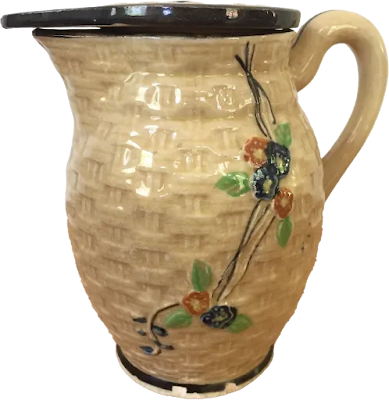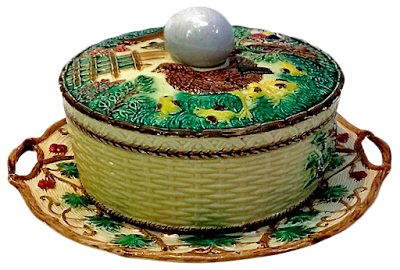I love watching old episodes of Antiques Roadshow UK. As I have written before, I far prefer the UK version of Antiques Roadshow to the one made in the US mainly because the quality of antiques are of a higher caliber, and older than those shown in America. They also give more realistic evaluations, not pumping the value up for sensationalism the way the US version does.
As I was watching a show recorded at Barrington Court on May 17, 2015 (S37 E22), I was delighted to see a rare piece of Copeland majolica pop up.
A woman brought in a piece of majolica she and her husband had purchased in 1973 on an installment plan. It cost them £39 10s.
The appraiser, Fergus Gambon, who is currently the director of British Ceramics and Glass at Bonhams UK (and the son of the late actor Sir Michael Gambon), found it unusual having never seen it before among the many pieces of majolica previously brought in for appraisals. He identified it as a piece of Copeland, a company he described in a dismissive manner the way only the British can, as a "second division" majolica manufacturer. (I will say, that the snobbery common on the UK version of Antiques Roadshow is the thing I like least about the program.)
The owner had done some research and though she originally thought it was made for plover eggs she knew she was on the wrong track when she saw that plovers do not have a crest but another bird popular at the time did. It was a piece specifically made for holding lapwing eggs, which apparently were fashionable for Easter with Queen Victoria who liked hers served in aspic. She also mentioned that there were recipes for them in Mrs. Beeton's Book of Household Management, where they are described thus:
"Those [eggs] of land birds that are eaten, as the plover, lapwing, ruff, etc., are in general much esteemed."
He pointed out the unusual mark on the base that included "copyright reserved" in addition to the impressed Copeland mark. He did not show the date code.
I will say that in spite of Copeland being “second division” he still liked it and gave it a value of £500-£600 in 2015 even with its repaired beak.
Of course, now lapwings are critically endangered probably due to all this lapwing egg gathering during the reign of Victoria so chicken or quail eggs would make a good substitute if you choose to use your lapwing egg holder next Easter.
Honestly, the things you can learn on Antiques Roadshow!








































































